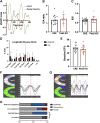Deletion of cardiac polycystin 2/PC2 results in increased SR calcium release and blunted adrenergic reserve
- PMID: 32946258
- PMCID: PMC7789970
- DOI: 10.1152/ajpheart.00302.2020
Deletion of cardiac polycystin 2/PC2 results in increased SR calcium release and blunted adrenergic reserve
Abstract
Transient receptor potential proteins (TRPs) act as nonselective cation channels. Of the TRP channels, PC2 (also known as polycystin 2) is localized to the sarcoplasmic reticulum (SR); however, its contribution to calcium-induced calcium release and overall cardiac function in the heart is poorly understood. The goal of this study was to characterize the effect of cardiac-specific PC2 deletion in adult cardiomyocytes and in response to chronic β-adrenergic challenge. We used a temporally inducible model to specifically delete PC2 from cardiomyocytes (Pkd2 KO) and characterized calcium and contractile dynamics in single cells. We found enhanced intracellular calcium release after Pkd2 KO, and near super-resolution microscopy analysis suggested this was due to close localization of PC2 to the ryanodine receptor. At the organ level, speckle-tracking echocardiographical analysis showed increased dyssynchrony in the Pkd2 KO mice. In response to chronic adrenergic stimulus, cardiomyocytes from the Pkd2 KO had no reserve β-adrenergic calcium responses and significantly attenuated wall motion in the whole heart. Biochemically, without adrenergic stimulus, there was an overall increase in PKA phosphorylated targets in the Pkd2 KO mouse, which decreased following chronic adrenergic stimulus. Taken together, our results suggest that cardiac-specific PC2 limits SR calcium release by affecting the PKA phosphorylation status of the ryanodine receptor, and the effects of PC2 loss are exacerbated upon adrenergic challenge.NEW & NOTEWORTHY Our goal was to characterize the role of the transient receptor potential channel polycystin 2 (PC2) in cardiomyocytes following adult-onset deletion. Loss of PC2 resulted in decreased cardiac shortening and cardiac dyssynchrony and diminished adrenergic reserve. These results suggest that cardiac-specific PC2 modulates intracellular calcium signaling and contributes to the maintenance of adrenergic pathways.
Keywords: CICR; adrenergic stimulus; calcium release; cardiac dysfunction; echocardiography; excitation-contraction coupling.
Conflict of interest statement
J.A.K. is on the editorial board of the
Figures







Similar articles
-
Decreased polycystin 2 expression alters calcium-contraction coupling and changes β-adrenergic signaling pathways.Proc Natl Acad Sci U S A. 2014 Nov 18;111(46):16604-9. doi: 10.1073/pnas.1415933111. Epub 2014 Nov 3. Proc Natl Acad Sci U S A. 2014. PMID: 25368166 Free PMC article.
-
Regulation of ryanodine receptor-dependent calcium signaling by polycystin-2.Proc Natl Acad Sci U S A. 2007 Apr 10;104(15):6454-9. doi: 10.1073/pnas.0610324104. Epub 2007 Apr 2. Proc Natl Acad Sci U S A. 2007. PMID: 17404231 Free PMC article.
-
Polycystin-2-dependent control of cardiomyocyte autophagy.J Mol Cell Cardiol. 2018 May;118:110-121. doi: 10.1016/j.yjmcc.2018.03.002. Epub 2018 Mar 6. J Mol Cell Cardiol. 2018. PMID: 29518398
-
Polycystin 2: A calcium channel, channel partner, and regulator of calcium homeostasis in ADPKD.Cell Signal. 2020 Feb;66:109490. doi: 10.1016/j.cellsig.2019.109490. Epub 2019 Dec 2. Cell Signal. 2020. PMID: 31805375 Free PMC article. Review.
-
Adrenergic Regulation of Calcium Channels in the Heart.Annu Rev Physiol. 2022 Feb 10;84:285-306. doi: 10.1146/annurev-physiol-060121-041653. Epub 2021 Nov 9. Annu Rev Physiol. 2022. PMID: 34752709 Free PMC article. Review.
Cited by
-
The endoplasmic reticulum luminal Ca2+ regulates cardiac Ca2+ pump function.PNAS Nexus. 2025 Feb 7;4(2):pgaf045. doi: 10.1093/pnasnexus/pgaf045. eCollection 2025 Feb. PNAS Nexus. 2025. PMID: 39959711 Free PMC article.
-
Utilization of the genetically encoded calcium indicator Salsa6F in cardiac applications.bioRxiv [Preprint]. 2023 Nov 23:2023.11.22.568284. doi: 10.1101/2023.11.22.568284. bioRxiv. 2023. Update in: Cell Calcium. 2024 May;119:102873. doi: 10.1016/j.ceca.2024.102873. PMID: 38045325 Free PMC article. Updated. Preprint.
-
Role of PKD2 in the endoplasmic reticulum calcium homeostasis.Front Physiol. 2022 Aug 10;13:962571. doi: 10.3389/fphys.2022.962571. eCollection 2022. Front Physiol. 2022. PMID: 36035467 Free PMC article. Review.
-
Echocardiographic characteristics of autosomal dominant polycystic kidney disease.Sci Rep. 2024 Dec 2;14(1):29867. doi: 10.1038/s41598-024-81536-2. Sci Rep. 2024. PMID: 39622918 Free PMC article.
-
Cardiovascular Manifestations and Management in ADPKD.Kidney Int Rep. 2023 Aug 4;8(10):1924-1940. doi: 10.1016/j.ekir.2023.07.017. eCollection 2023 Oct. Kidney Int Rep. 2023. PMID: 37850017 Free PMC article. Review.
References
-
- Altamirano F, Schiattarella GG, French KM, Kim SY, Engelberger F, Kyrychenko S, Villalobos E, Tong D, Schneider JW, Ramirez-Sarmiento CA, Lavandero S, Gillette TG, Hill JA. Polycystin-1 assembles with Kv channels to govern cardiomyocyte repolarization and contractility. Circulation 140: 921–936, 2019. doi:10.1161/CIRCULATIONAHA.118.034731. - DOI - PMC - PubMed
Publication types
MeSH terms
Substances
Grants and funding
- R01HL136737/HHS | NIH | National Heart, Lung, and Blood Institute (NHBLI)/International
- K99 DK101585/DK/NIDDK NIH HHS/United States
- R01 HL136737/HL/NHLBI NIH HHS/United States
- R01DK101585/HHS | NIH | National Institute of Diabetes and Digestive and Kidney Diseases (NIDDK)/International
- R01 HL130231/HL/NHLBI NIH HHS/United States
LinkOut - more resources
Full Text Sources
Molecular Biology Databases
Research Materials
Miscellaneous

